Chesapeake Light Craft developed the Oxford Rowing Shell for a seemingly large niche that hasn't been filled by other boat designers. So many people are fascinated, almost compelled by the vision of a scull slipping sleekly through the morning fog on a mirror of water that they are willing to spend exorbitant sums of cash to have one. Frequently the boats they buy are heavy recreational shells or extremely expensive and difficult to row racing boats, which test the mettle of even the most dedicated racer. My wife, being one of those that has for years loved the concept and the quiet beauty of rowing, watched our local college crew boats melt out of and back into the fog on cool fall mornings. She decided that rowing was to become a part of her workout schedule, so being her loving boat builder, I decided to put together a boat that met her needs. After training in a Thames Rowing Wherry, it was time to step up to something low, fast, and light.
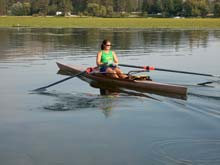 |
My wife, being one of those that has for years loved the concept and the quiet beauty of rowing, so being her loving boat builder, I decided to put together a boat that met her needs. |
After completion of an almost 2 year long power launch build, I decided a smaller project sounded far less labor intensive and relaxing. Thanks to our beautiful weather here in eastern Washington, much time could be devoted to cored composite construction, ie., glass sheathed plywood. While I really loved the lines of the Oxford, I did note that once rigged, it would be pushing the weight of our heaviest kayak, and difficult for my wife to launch by herself (she being one of none-too-grand stature). This initiated a short but extremely information laden conversation with John C. Harris over at Chesapeake Light Craft. He was very forthright in his knowledge and ideas behind the boat, and was willing to let me throw ideas at him. After a few emails back and forth, he gave me the nod to build what was to be considered an "experimental" Oxford.
The changes included:
- Bottom panels reduced from 4mm to 3mm
- Reducing tape from 9oz to 6oz
- Reducing sheathing glass from 4oz to 3.25oz
- Replacing Sitka Spruce with Western Red Cedar (had it on hand) for sheer clamps
| After a few emails back and forth, John Harris of CLC gave me the nod to build what was to be considered an "experimental" Oxford. |
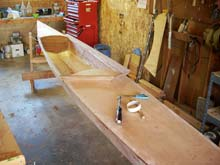 |
Mr. Harris noted that this isn't a build for someone without experience, and could lead to a boat with poor performance or structural problems if any sort of error in construction occurred. Those reading this article are to bear that in mind when contemplating the experimental Oxford, and should typically build per plans.
The construction went moderately well considering the various changes made. Stitching using the CLC method is simple and effective, though through past builds I have shied away from using wire stitching and leaving it in place. I now use plastic wire ties in the same stitching schedule, but add a small step to reduce weight and metals in the boat. Between stitches, I will add a bead of thickened epoxy to spot weld the seams together. Once cured, I can remove the stitches and finish the hull without any sort of metal embedded in the chines. I prefer this, but many builders may still choose to use the copper wire for the stronger pull, reduced breakage, and fewer steps.
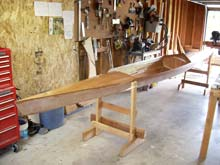 |
The construction went moderately well considering the various changes made. |
Using the 3mm okoume ply for the bottom panels turned out to be somewhat of a challenge as it is a very flexible 3 ply material. After a little manipulation, I would recommend to any builder that they be certain all seams are extremely fair. The 3mm will deform at the slightest provocation, so be wary. Cedar worked reasonably well as a sheer clamp, and any builder not in the Pacific Northwest should be more than pleased with spruce as the clamp. I happened to have a pair of 3/4" pieces already scarfed together in my rafters to 24 feet, so I used what was on hand.
| Fiberglassing with 3.25oz fabric is a dream after using 18oz biax on the last project. 2 coats of clear epoxy filled the weave and left a buttery smooth finish coat that anyone could be happy with. |
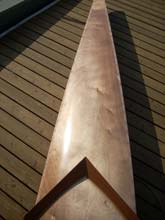 |
Fiberglassing with 3.25oz fabric is a dream after using 18oz biax on the last project. 2 coats of clear epoxy filled the weave and left a buttery smooth finish coat that anyone could be happy with. Interior tape also was extremely easy in all but the bow and stern edges. It can be somewhat difficult taping the bow, as once the sheer clamps are in place the pocket to run your fillet and tape is very deep. Be aware that this build was very lightweight and required these joints to go in flawlessly.
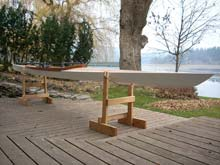 |
Once finished, the boat weight measurement showed us a 4 lb improvement in hull weight, dropping the quoted 39lbs to 35lbs. I feel this was worth the labor and mental exercise. |
Once finished, the incredibly accurate "bathroom scale" method of boat weight measurement showed us a 4 lb improvement in hull weight, dropping the quoted 39lbs to 35lbs. I feel this was worth the labor and mental exercise. Once rigged with a 15lb RowWing rowing rigger, the completed boat is only a pound heavier than her kevlar touring kayak. This makes the boat far more likely to get used, since it isn't a chore to launch and retrieve it every day. I haven't found any weaknesses in the boat, though one should never step on the thin bilge panels, always on the rigger rail, when boarding.
| Once rigged with a 15lb RowWing rowing rigger, the completed boat is only a pound heavier than her kevlar touring kayak. |
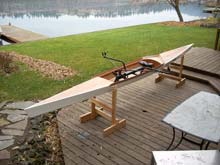 |
My lovely wife reports that it performs amazingly well. Her time to certain points on the lake has improved by 50% over the 17 foot sliding seat wherry she was rowing before. Speeds up to 7kts are possible in short bursts. Initial stability isn't all that bad for a boat with only 22" of beam, and closer to 20" at the waterline. She gets up to speed very quickly, in as little as 3 strokes, and seems to peel almost no stern wave whatsoever, even with my 200lb frame in the boat. Tracking is somewhere between excellent and superb. After this build, my bride has been so pleased that she will allow another 20+ foot power vessel to take up half the garage and half my time.
Its the little things in life. As she tells me every so often:
" Happy Wife, Happy Life "
***** |

